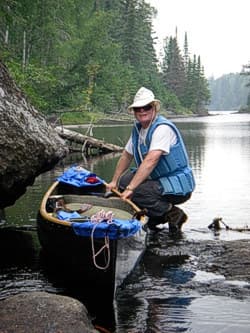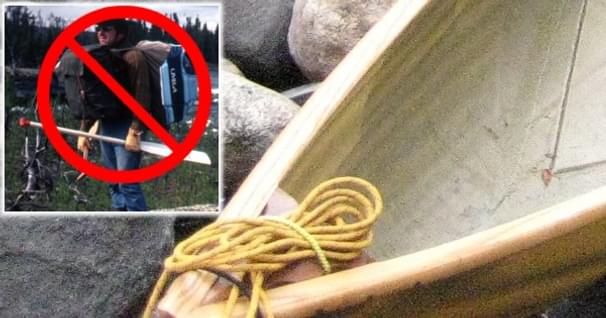Duluth Packs - Birth of a Legend
The idea to produce a packsack for campers and canoeists probably emerged while watching streams of hunters, fishermen, miners and canoeists flock past Duluth, Minnesota enroute to the Arrowhead region--gateway to the now famed Boundary Waters Canoe Area. Well made backpacks were rare in the 1890's: most turn-of-the-century explorers packed their gear inside wooden wanigans, barrels, woven ash baskets and tumpline-lashed canvas rolls.
Camille Poirier saw a need for sturdy, affordable luggage that would stow easily in a canoe, boat or wagon. He envisioned a line of progressively sized packs that were easy to construct and simple to repair in the field. Poirier carefully worked out the construction procedures, which might have gone something like this:
- Cut a simple rectangular pattern from water-resistant fifteen ounce canvas (the best modern Duluth packs now use 18 ounce material).
- Sew and rivet leather shoulder straps and steel buckles to the outside of the fabric at marked points.
- Provide seam allowance and room for a long closing flap, then turn the fabric wrong side out and sew up the sides. Attach a tumpline at the customer's request.
What could be simpler? Or more ingenious!
Patented in 1892 by Camille Poirier, the "Duluth" pack, as it would come to be known, combined strength, endurance and quiet elegance in a soft appealing package that would stand the test of time. Now, at least four Minnesota companies-Cooke Custom Sewing, Duluth Pack and Frost River offer Poirier styled (aka "Duluth") packs. And while sales of some modern packs may have peaked, demand for classic Duluth packs continues to grow. A new generation of wilderness paddlers is following the lead of versatility-conscious old timers who value traditional gear and traditional ways.
If you've never used Duluth packs--or used them "incorrectly"--you may wonder why experienced canoeists often prefer them to modern packs of more sophisticated breeding. After all, what could be attractive about a floppy century old design that has no padded shoulder straps or hip belt, no sternum strap, zippered pockets, supporting frame or quick-release plastic buckles? Why on earth would anyone choose a shapeless mass of heavy, rot-prone canvas over a decay-defying, crisply patterned nylon pack built from indestructible modern materials?
To understand the lure of the ageless Duluth pack, we must explode some popular myths:
Myth: Modern nylon tripping packs are more comfortable to carry than traditional canvas Duluth packs.
True only if you place hard items against your back and don't use a tumpline!
A tumpline is a wide strap that attaches to a pack or bundle. You place this strap just above your forehead, lean forward into the trace, and take off down the trail. The early Voyageurs carried hundreds of pounds with this rig, often stacking bundles a yard high over their heads. You may follow the lead of these historic canoe men by placing awkward bundles, like day packs, paddles and fishing rods, under the tump strap in the hollow of your back. When your neck and head begin to ache, cast off the tumpline and shift the load to the shoulder straps . Change back to the headstrap when the pain is gone. Though, "stacking" produces an awkward load which is unsuitable for serious hiking, it speeds progress on the short portages that characterize most canoe trips.
The key to comfortable packing is keeping the load tight against your back--easy enough when you're hiking on the flats or downhill. But ascend a steep grade and gravity will tear at your pack and threaten to bowl you over backwards. Contoured pack frames and padded hip belts help stabilize the load, but only a tumpline anchors it tight against your back when going uphill. The advantages of a tumpline on uphill grades are so pronounced that I urge you to try this simple experiment:
Carry a heavy backpack up a steep stair case using the shoulder straps alone, then add a makeshift tumpline and repeat the procedure. Be sure you attach the tumpline below the point where the shoulder straps are sewn to the pack. You'll have to slightly loosen the shoulder straps to transfer the weight of the pack to the tumpline.
Important: take time to adjust the tumpline right! What works for one Voyageur is wrong for another. Consider this before you give up on the grand idea.
Since tumplines transfer nearly all the weight of the pack to your strong neck muscles, they negate the value of hip belts, frames, contoured shoulder straps and other sophisticated--and expensive--features.
Myth: Duluth packs ride too high in a canoe. Modern side-wall packs can be set belly down in the hull, which lowers the canoe's center-of-gravity.
The recommended number three size (24" x 30") Duluth pack is expressly designed to sit upright in a canoe, with its opening out-of-contact with bilge water. A properly loaded #3 Duluth pack extends no more than six inches above the rails of a deep hulled tripping canoe. The resultant arched load helps support and drain a fabric splash cover.
To load a Duluth pack into a canoe, grab the pack by the "ears" of its closing flap and, with a deft motion, swing it over the gunnels and plop it on the floor--no bending or stooping required.
Conversely, modern "side-wall" packs sit too high when placed upright in a canoe. They must be placed belly down or sideways in the craft. This requires considerable bending and stooping--a scenario that will be repeated at every portage. More importantly, the mouth of an upright Duluth pack is out-of-contact with accumulated bilge water, while that of a belly down, long profile pack is submerged. Carelessly waterproof the contents of a horizontally placed pack and you'll know it when the first wave comes over the bow. Gear packed in an upright Duluth pack stays dry unless you capsize!
Accessibility to small items: The zippered pockets on the face of some modern packs seem like a great place to store small items--that is,until you discover that the zippers are submerged in bilge water when the pack is placed face down in the canoe. If you set the pack backside down, you'll have water-soaked shoulder straps and fabric against your back on the next portage. The solution is to adopt a pack that sits upright in the canoe--one whose front and back don't touch bilge water. Only the traditional Duluth pack qualifies!
Myth: Modern nylon packs will outlive canvas Duluth packs. This is pure baloney. I have canvas Duluth packs which date to 1966 and have seen upwards of 100 canoe trips with grueling portages of over three miles. With the exception of some expected patches, all are going strong. I can't say the same for my modern packs of equivalent age.
Quick! What's the first thing to fail on a serious tripping pack? If you said zippers first, shoulder straps second, you're right on target. To replace foam encased nylon shoulder straps, you must rip out the straps and the foam and re-sew the yoke--a task best reserved for the manufacturer.
On the other hand, when (and if) full grain leather shoulder straps break, it's usually at a buckle hole. Field first-aid means riveting on a healthy piece of leather or nylon webbing. What could be simpler? Or faster?
There's no contest when it comes to longevity of material. "Scientific" tests suggest that nylon outlasts canvas, though in the field, where abrasion is the real culprit, canvas often comes out on top. Drag an 18 ounce canvas Duluth pack repeatedly over hard granite and notice how the fibers "give" and return to their previous arrangement. Now, observe the unyielding flow of coated nylon as you repeat the experiment. Flexible wooden canoe hulls often outlast stiff foam-cored Kevlar™ ones for the same reason.
Myth: Modern tripping packs are more waterproof than Duluth packs. No pack is 100 percent waterproof over the long haul. Those that are watertight when new, are either slow and awkward to use, or uncomfortable to portage and/or difficult to stow in a canoe. All develop holes after a few years of strenuous canoe travel.
Experienced canoeists know that any packsack which is advertised as "waterproof" may fail at a critical time. For this reason, they prefer to build a reliable waterproofing system inside each pack. Many, like myself line their packs with two nearly puncture-proof 6-mil thick plastic asbestos-removal bags. These giant bags last for years, though at one dollar apiece, you can afford to replace them each season.
Myth: Wet nylon packs dry more quickly than canvas Duluth packs. It's certainly true that non-absorbent nylon dries more rapidly that porous canvas. However, the roles are often reversed after a heavy rain or capsize.
Scenario: part way down the rapid, a rock looms into view. You apply a powerful bow draw, but it isn't enough. Seconds later, everyone and everything is in the moving water. It's not a serious situation--the water is warm and you retrieve your gear quickly. But your two packs--one canvas, one nylon--are soaking wet. Thank goodness you lined them both with plastic asbestos bags.

It's getting late and you're anxious to camp before the sun goes down, so you momentarily invert your packs on a rock to eliminate the accumulated water. Then, you put them back into the canoe and paddle on.
Ten minutes later, the outside of the nylon pack is dry to the touch. Thirty more minutes pass before the canvas follows suit. An hour later, you pitch camp and begin to unpack your things. You open the flap of the canvas Duluth pack and notice that everything--even the space between the outer plastic bag and pack canvas is bone dry. You chuckle at the observation. Canvas is breathable, remember? Accumulated water flowed out through the weave and the remaining moisture evaporated.
And now to the waterproof nylon pack. As mentioned, the outside is dry, but the space between the coated nylon material and plastic bag liner is soaking wet. Of course! You mutter disgustedly. Water can't escape through a fabric that has no holes. You'll have to remove the pack contents and both plastic liners and turn the pack inside out to dry!
Yes! coated nylon does dry faster than porous canvas, but only if you expose both sides of the material to the warmth of the sun!
Myth: Plastic FASTEX™ buckles, like those found on modern tripping packs are easier to operate than the nickel-plated steel roller buckles found on traditional Duluth packs. It's simply a matter of learning a few tricks. You can make a quick-release buckle out of any leather Duluth pack strap by leaving a small loop of leather between the steel buckle pin and strap retaining bar on the roller. If you want a still faster release, run the buckle pin through the hole in the closing strap, but don't push the strap end through the roller bar. Experienced Boundary Waters/Quetico Park travelers often use this "half-locked" procedure.Myth: Modern FASTEX™ buckles are stronger than old fashioned steel buckles. For many years, I guided canoe trips into northern Canada for the Science Museum of Minnesota and Piragis Northwoods Co. My clients used a variety of traditional and modern packs. On a Seal River canoe trip, we broke two FASTEX™ buckles--one on an expensive tripping pack, the other on a small fanny pack. On the Hood River in 1992, a pack zipper failed, and a nylon shoulder strap tore loose from its stitching. We also cracked an ABS plastic wanigan box.
In all my years of canoe tripping, I have experienced just one Duluth pack failure: a buckle rivet pulled loose and we were able to repair it in less than five minutes!
Myth: A hip belt (which Duluth packs don't have) is needed to carry heavy loads comfortably over rough terrain. It is a fact that all the best hiking packs have padded hip belts which transfer part of the weight from your shoulders to your hips. Hip belts increase control on the flats and downhill grades, but they don't help at all on inclines. Hip belts also interfere with anything (sheath knife, multi-pliers, etc.) you wear around your waist.
Hip belts are terribly awkward in canoes. They catch on thwarts and seats during loading operations and they remain submerged in bilge water and muck for long periods of time. Each time you portage you clip the dirty, foul-smelling strap around your waist. Whenever you set the pack down on a rotting cedar or the sharp granite of the Canadian shield, abrasion and crud takes its toll. Eventually, the nylon shell tears and exposes the foam padding inside.
Hip belts are great for serious hiking, but they are a nuisance on the short portages which characterize most canoe country. Equip your portage pack with a tumpline and you'll have no need for a hip belt.
Two less obvious advantages of Duluth packs include low cost and extended capacity. Sophisticated features don't come cheap. State-of-the-art canoeing luggage costs about twice as much as traditional Duluth packs. A backpacker needs just one pack; a serious wilderness canoeist requires at least three!
Extended capacity: After a rain or capsize, you may have some wet, bulky gear that won't fit inside your pack. There's always room to "stuff one more thing" under the serviceably long closing flap of a classic Duluth pack. Nearly all modern packs have closing flaps that are too short.
Even die hard traditionalists will readily admit that modern materials and methods have smoothed the outdoor experience. Today's best tripping canoes, tents, cookware and clothing are lighter, stronger and more versatile than similar products of decades ago. But the buck stops at the original canvas Duluth pack, whose strength, versatility and long haul durability, continues to challenge state-of-the-art competitors, and whose earthy smell and soft natural feel fits in with foggy mornings, bright campfires, and starry nights.
Combed cotton canvas, leather straps and solid copper rivets. Like a brightly varnished wood-ribbed Thompson or Old Town canoe, a well cared for Duluth pack endures. Camille Poirier would have wanted it that way.
Cliff Jacobson is a professional canoe guide and outfitter for the Science Museum of Minnesota, a wilderness canoeing consultant, and the author of more than a dozen top-selling books on camping and canoeing. www.cliffcanoe.com
Related Articles
Wondering what to wear when going paddling? Answer 4 quick questions and instantly learn what you need…
In 1971, I outfitted and guided three wealthy Chicago men--the least affluent of which earned a quarter…
Drying is probably the most ancient way to preserve food for a very long period of time. You have…
In the mid-seventies, I shared an afternoon with the famous woodsman, Calvin Rutstrum, whose flagship…



